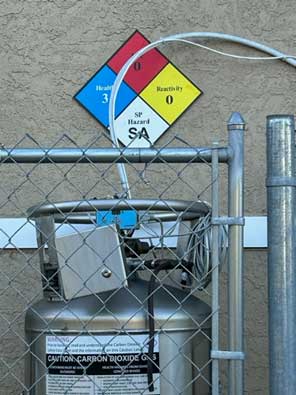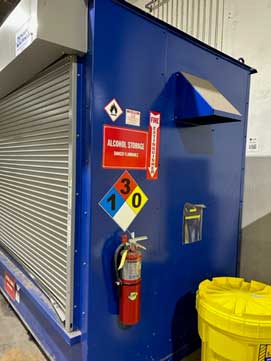By BRIAN DABOUL
Commonly known as the “fire diamond” or “safety square”, the National Fire Protection Association (NFPA) 704 placarding system is a first responder awareness skill and must be fully understood by first responders to avoid undesirable outcomes when responding to locations containing hazardous materials. The system was created in 1959 by fire marshal J.F. Morris of the Charlotte (NC) Fire Department after 13 firefighters were injured, some critically, during a response to the Charlotte Chemical Company. Firefighters responded to a fire in a vat that was assumed to contain kerosene. The vat actually contained metallic sodium, which reacted violently to suppression efforts. The solution put forth by Morris was a diamond separated into four smaller diamonds and color-coded by hazard type. Each hazard type would be rated from 0 to 4 based on criteria discussed further in this article. A space also existed for special hazards to be called out by symbols or abbreviations. The system was tentatively adopted as a guide in 1960 and has since undergone several revisions, resulting in what we now know as NFPA 704, Standard System for the Identification of the Hazards of Materials for Emergency Response.
- Hazmat Response and the Fire Codes
- Construction Concerns: Classification of Flammable and Combustible Liquids
- The Process of Making Decisions At Hazardous Materials Incidents
Where Is It Used?
The NFPA 704 placarding system is for use on fixed locations such as buildings, storage, tanks, and doors into storage areas. Although you may see an NFPA 704 used on chemical containers such as drums or bottles, it is much more common to see Globally Harmonized System of Classification and Labelling of Chemicals (GHS) pictograms and compliant labeling on those types of containers. For hazardous materials in transportation, the DOT placarding system is the required method, and NFPA 704 shall not be used in those cases. Local authority having jurisdictions such as fire officials and code enforcement determine where NFPA 704 placarding must be used as well as the required size of the placard for visibility distance. Typical locations for the placarding to be located include building exteriors near each entrance that first responders may use, on exterior doors that enter directly into a chemical storage area, chemical storage buildings, or permanent chemical tanks.


Understanding the Rating System
When looking at the NFPA 704 placard, the left blue diamond alerts responders to the health hazard rating. A “0” would indicate no unusual hazard of concern and is the best possible situation. A “1” indicates possible irritation, such as skin or eyes, whereas a “2” indicates harm if inhaled or absorbed. Once a “3” is placed in this diamond, the material may either be corrosive or toxic. A worst-case scenario would be a “4” rating, indicating that short exposures may become fatal.
The top red diamond signifies the fire hazard and flammability or combustibility of the substance. Again, the best possible rating is a “0,” which means the substance is not combustible, whereas a “1” means limited combustibility where the substance must be directly heated above 200°F. Once a rating of a “2” is observed, this now indicates a flammable substance with a flashpoint between 100-200°F. A rating of “3” is any substance with flashpoint below 100°F, while a “4” has a flashpoint below 73°F. This is one of the most sought-after pieces of information for fire departments when responding.
On the right, you will find a yellow-colored diamond which tells you of the reactivity or instability of the substance. Stable substances receive a rating of “0,” while substances that react if heated in a nonviolent manner receive a rating of a “1.” A “2” would be assigned if the product is unstable and may react violently. Once a rating of “3” is reached, that substance now may be explosive if subject to electrical shock or heated or if it interacts with water. This rating may be a bit broad, and further information should be sought either from site management or safety data sheets (SDS) to determine the exact reactivity hazards. Worst-case scenario is a rating of a “4,” indicating the substance is explosive at room temperature.
- Hazmat Response and the ABCs
- Everyday Hazmat: The Inappropriate Mixing of Household Chemicals
- Hazmat Survival Tips: Hazardous Materials Incident Size-Up
- RAPID HazMat for Safe and Quick Response
Special Hazard Markings
Now that you understand the three-color coded sections, the final section is the white diamond on the bottom. Many times, this may be blank, which indicates no other known special hazards. This is the section where special hazards can be spelled out either by accepted standard abbreviations or by symbols. Below are the abbreviations and symbols that are used with explanations of each:
- SA (Simple Asphyxiant): A simple asphyxiant is a gas or vapor that can cause unconsciousness or death by suffocation. These substances act by displacing oxygen and creating an oxygen deficient atmosphere (below 19.5% O2). Common substances with this designation include nitrogen, argon, helium, methane, propane, carbon dioxide, neon, and xenon.
- ACID (Acidic Substance): A substance is considered acidic when it is anywhere on the pH scale from 0-6.9. The lower the number, the more acidic the substance is. Common acids are nitric acid, phosphoric acid, and sulfuric acid. The main hazard here is the corrosive properties of the acid, which vary from substance to substance.
- ALK (Alkaline Substance): Alkaline substances are on the opposite end of the pH scale from acids, anywhere from 8-14. Substances in the middle at 7 are considered neutral. Alkaline substances can also have various corrosive properties. Commonly encountered alkaline substances include sodium hydroxide (commonly known as lye or caustic soda), potassium hydroxide, and sodium bicarbonate.
- COR (Corrosive Substance): A corrosive substance can be either an acid or alkaline substance. A placard with this indication can mean the presence of either one of those hazards, or both. When both an extreme acid and alkaline are present, use caution. Should both substances mix from a spill or fire suppression water, an exothermic reaction may take place, which produces heat.
- OXY (Oxidizer): Oxidizers are solids, liquids, or gases that react readily with most organic material or reducing agents. Oxidizers are not directly flammable or combustible, but they intensify combustion and increase the flammable range for chemicals so they ignite more readily and burn hotter and faster. Common oxidizers are hydrogen peroxide, nitric acid, fluorine, chlorine, oxygen, and bromine.
- P (Polymerization): Polymerization occurs when small molecules in a substance called monomers chemically combine to form a polymer. This is often an exothermic process and can lead to fire or explosion. Polymerization happens rapidly and typically cannot be controlled by first responders, which is why it is a high hazard. Common polymers include LDPE, HDPE and polypropylene plastics, polyvinyl chloride, nylon, and nonstick coating.
- C (Carcinogen): Carcinogens are substances that cause cancer over time from exposure. These substances may include asbestos, nickel, cadmium, and vinyl chloride.
- POI (Poison): Poison refers to anything that is immediately dangerous to the life and health of a person. This can be a liquid, gas, or solid. Proper identification shall be made prior to interacting or entering an area with this designation.
- RAD or RA (Radioactive): Radioactive substances emit radiation either in the form of alpha, beta, or gamma particles. The symbols RAD or RA are both used as well as the radiation symbol known as the trefoil sign. If radiation warnings are present, proper hazardous materials responders shall be summoned to the scene as most first responders don’t have the knowledge or equipment to manage these items effectively and safely. Uranium and plutonium are known radioactive elements, but any number of items may be radioactive, especially in the healthcare industry, where radiation is used for medical purposes in controlled manners.
- CRY or CRYO (Cryogenic): A cryogenic substance has a boiling point below negative 130°F (negative 90°C) and are used to provide extremely low temperatures. Substances such as liquid nitrogen, liquid hydrogen, and liquefied natural gas (LNG) are all cryogenic liquids.
- Biohazard: Biohazards are marked with the biohazard symbol, which all responders shall be aware of. Biohazards are infectious agents and include viruses, human blood, used sharps, or animal waste.
- Water Reactive: Water-reactive substances are marked by a “W” with a line through it, indicating not to use water. This is extremely important to responders arriving at a fire as a different extinguishing agent may be required. Common water-reactive substances include lithium, magnesium, calcium, and aluminum. Class D combustible metals are included in this category, as well.
Multiple Chemical Hazards
You may be asking yourself: What happens when there are multiple different chemicals stored in one area with different hazards? Well, NFPA 704 has three methods to handle this situation, outlined in section 4.2.3.3 of the standard. First is the composite method, where a single placard is posted showing the maximum rating in each category. For example, if you have two chemicals with one having a flammability rating of “1” and the other with a rating of “3,” then the placard would show a “3” for flammability.
The second method is the individual method, where an individual placard for each chemical is posted with a separate sign under each placard listing the chemical name for responder clarification. This can become cluttered and complicated when multiple chemicals are in one area with limited space for placard posting, but it is the most effective method.
The third method is referred to as the composite-individual method, which would involve a mix of both above approaches. This method should only be used when absolutely necessary as it can become confusing to first responders.
Training Opportunities
Understanding chemical placarding, including the NFPA 704, is a skill not often exercised by most responders. Instructors must integrate these skills into other training. Conducting an initial and annual refresher training on hazard communication is great, but it is not adequate. During activated alarm responses, take the time to review the markings with your crew, ask questions of the building manager, and understand the exact chemicals and hazards that sit behind those placards. Ever have a drill or work night where you don’t have anything planned? Routine apparatus operator training going on? Stop and identify placards you see and discuss the hazards they indicate. It is your job as the company officer or department training officer to ensure your responders understand how to interpret and recognize chemical hazards.
References
“July Marks 62 Years Since Charlotte Fire Invented Haz-Mat Safety Measure.” Queen City News
NFPA 704, Standard System for the Identification of the Hazards of Materials for Emergency Response. 2022 edition. NFPA.org/codes
BRIAN DABOUL is a 14-year veteran of the Mine Hill Township (NJ) Fire Department, spending the past five years as a chief officer and another three years as a line officer. He has also managed compliance for environmental health and safety at a senior management level in consumer goods—including in the pharmaceutical, nutraceutical, cosmetic, food, and manufacturing industries—for 13 years.
Occupational Health and Safety Compliance for the Volunteer Fire Service

